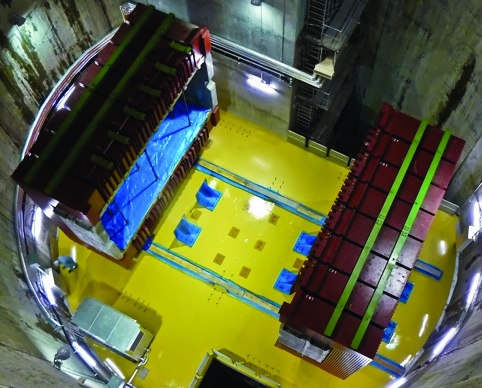A number of international teams are currently looking at the elusive neutrino, which is the second-most abundant particle in the universe (after photons) but has no charge and very rarely interacts with matter.
Because they are so difficult to detect, physicists and engineers often have to come up with entirely novel infrastructure for detecting and analysing them — one experiment in the South Pole is drilling a series of 1.5km holes into the ice sheet and threading through beaded strings of detectors.
In Japan meanwhile, the 2TK experiment generates muon neutrinos at the J-PARC accelerator in Tokaiand and sends them in a beam towards the Super-Kamiokande detector in Kamioka, 295km away.
The key to the experiment is that neutrinos exist in three ‘flavours’ — muon, electron and tau, which can oscillate from one state to another as they travel in space — or, in the case of the 2TK, the Earth’s crust.
The Super-Kamiokande is able to detect what particles end up as, but in order to ascertain how they change on their journey another ‘near detector’ is needed right next to the beam source, and this is what the UK team was responsible for designing and building.
‘Obviously you need to produce them and detect them but you must be sure you understand what the exact properties of the original beam are before oscillation,’ Prof Christos Touramanis of Liverpool University, part of the team behind the 2TK equipment, told The Engineer.
Dr Francesca Di Lodovico of Queen Mary University added: ‘The far detector is easier in some ways, it’s just a big tank of pure water. But the near detector is an entirely new technology, it’s very complex.’
In the first set of 2TK experimental results reported last week, six muon neutrinos that started off at the near detector transformed into electron neutrinos before reaching the far Super-Kamiokande detector.
It’s possible that similar reactions involving neutrinos and anti-neutrinos in the early universe could have skewed the ratio of matter and anti-matter production, leading to our matter-dominated universe.

Professor Dave Wark, of Imperial College, who heads the UK 2TK team, said last week: ‘People sometimes think that scientific discoveries are like light switches that click from “off” to “on”, but in reality it goes from “maybe” to “probably” to “almost certainly” as you get more data. Right now we are somewhere between “probably” and “almost certainly”.’
But results from a separate experiment in the US reported today, may have edged the state of the field further towards certainty.
The MINOS experiment at the US Department of Energy’s Fermi National Accelerator Laboratory (which also has a prominent UK contribution) observed muon neutrinos transforming into electron neutrinos in a similar way to 2TK.
While the two experiments use different methods and analytical techniques to look for this rare transformation, the latest result is ‘consistent with and significantly constrains a measurement reported by the 2TK’, according to a statement from Fermi lab.
‘One of the major contributions of the UK group was to the energy scale calibration of the experiments — we built a miniature version of the detector at CERN that was critical to MINOS,’ Dr Ryan Nichol of University College London told The Engineer.
Both the MINOS and the 2TK have received funding from the Science and Technology Facilities Council.




AI-generated medical responses need monitoring, study finds
This would negate most of the benefit of using AI in the first place, rather like the Locomotive Act 1865 that required any self-propelled road...